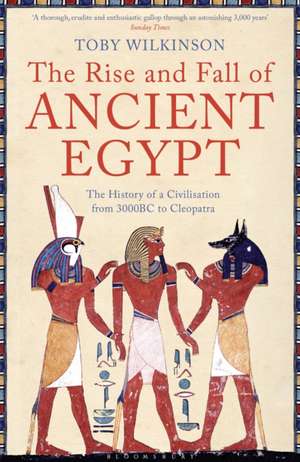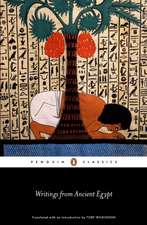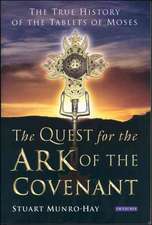The Rise and Fall of Ancient Egypt
Autor Toby Wilkinsonen Limba Engleză Paperback – 31 iul 2011
As the world's first nation-state, the history of Ancient Egypt is above all the story of the attempt to unite a disparate realm and defend it against hostile forces from within and without. Combining grand narrative sweep with detailed knowledge of hieroglyphs and the iconography of power, Toby Wilkinson reveals Ancient Egypt in all its complexity.
| Toate formatele și edițiile | Preț | Express |
|---|---|---|
| Paperback (2) | 87.10 lei 3-5 săpt. | +49.15 lei 4-10 zile |
| Bloomsbury Publishing – 31 iul 2011 | 87.10 lei 3-5 săpt. | +49.15 lei 4-10 zile |
| Random House Trade – 7 ian 2013 | 151.59 lei 3-5 săpt. |
Preț: 87.10 lei
Preț vechi: 110.75 lei
-21% Nou
Puncte Express: 131
Preț estimativ în valută:
16.67€ • 18.12$ • 14.01£
16.67€ • 18.12$ • 14.01£
Carte disponibilă
Livrare economică 01-15 aprilie
Livrare express 15-21 martie pentru 59.14 lei
Preluare comenzi: 021 569.72.76
Specificații
ISBN-13: 9781408810026
ISBN-10: 1408810026
Pagini: 672
Dimensiuni: 129 x 198 x 42 mm
Greutate: 0.62 kg
Editura: Bloomsbury Publishing
Colecția Bloomsbury Paperbacks
Locul publicării:London, United Kingdom
ISBN-10: 1408810026
Pagini: 672
Dimensiuni: 129 x 198 x 42 mm
Greutate: 0.62 kg
Editura: Bloomsbury Publishing
Colecția Bloomsbury Paperbacks
Locul publicării:London, United Kingdom
Caracteristici
The first major history of Ancient Egypt to marshal the detail of the lives of the pharaohs and of the ordinary citizens, to reveal the harsh political realities behind the 3000-year civilisation.
Notă biografică
Toby Wilkinson read Egyptology at Cambridge University. Since January 2004 he has been a Fellow of Clare College, Cambridge. An acknowledged expert on ancient Egyptian civilisation, he has given lectures around the world and his international reputation has led to invitations to contribute to other major collaborative projects. He is a member of the editorial board of the Journal of Egyptian History and has broadcast on radio and tv in the UK and abroad, including BBC's 'Horizon' and Channel 4's 'Private Lives of the Pharaohs', and was the consultant for the BBC's award-winning documentary on the building of the Great Pyramid. His books include the critically acclaimed Dictionary of Ancient Egypt and Genesis of the Pharaohs, and he edited the recent encyclopedia The Egyptian World. He lives in Cambridge.
Recenzii
'A sophisticated and complete account of the world's first nation state'
'Wilkinson's stirring and clear sighted account of the ancient world's most enduring civilisation comes as a welcome treat'
'I had always presumed, before I read Wilkinson's book, that it was impossible to write a history of Egypt which combined scholarship, accessibility, and a genuine sense of revelation. I was wrong'
'A comprehensive, illustrated history focusing on the dark side of the Pharaohs and some harsh political realities'
'Wilkinson's stirring and clear sighted account of the ancient world's most enduring civilisation comes as a welcome treat'
'I had always presumed, before I read Wilkinson's book, that it was impossible to write a history of Egypt which combined scholarship, accessibility, and a genuine sense of revelation. I was wrong'
'A comprehensive, illustrated history focusing on the dark side of the Pharaohs and some harsh political realities'
Descriere
A brilliantly readable, beautifully illustrated general history of ancient Egypt, from the builders of the first pyramids to Cleopatra
Extras
CHAPTER 1
IN THE BEGINNING
The first king of Egypt
In a tall glass case in the entrance hall of the Egyptian Museum in Cairo stands an ancient slab of fine-grained greenish-black stone, about two feet high and no more than an inch thick. Shaped like a shield, it is carved on both sides in low relief. The scenes, though still crisp, are difficult to make out in the diffuse, hazy light that filters down through the dusty glazed dome in the museum ceiling. Most visitors barely give this strange object a second glance as they head straight for the golden riches of Tutankhamun on the floor above. Yet this modest piece of stone is one of the most important documents to survive from ancient Egypt. Its place of honor at the entrance to the Egyptian Museum, the world's greatest treasure- house of pharaonic culture, underlines its significance. This stone is the object that marks the very beginning of ancient Egyptian history.
The Narmer Palette, as it is known to Egyptologists, has become an icon of early Egypt, but the circumstances of its discovery are clouded with uncertainty. In the winter of a.d. 1897-1898, the British archaeologists James Quibell and Frederick Green were in the far south of Egypt, excavating at the ancient site of Nekhen (modern Kom el-Ahmar), the "city of the falcon" (classical Hierakonpolis). The nineteenth century was still the era of treasure seeking, and Quibell and Green, though more scientific in their approach than many of their contemporaries, were not immune from the pressure to discover fine objects to satisfy their sponsors back home. So, having chosen to excavate at Nekhen, a site eroded by countless centuries and largely devoid of major standing monuments, they decided to focus their attentions on the ruins of the local temple. Though small and unimpressive by comparison with the great sanctuaries of Thebes, this was no ordinary provincial shrine. Since the dawn of history, it had been dedicated to the celebration of Egyptian kingship. The local falcon god of Nekhen, Horus, was the patron deity of the Egyptian monarchy. Might the temple, therefore, yield a royal treasure?
The two men worked away, and their initial results were disappointing: stretches of mud brick wall; the remains of a mound, faced in stone; a few worn and broken statues. Nothing spectacular. The next area to be investigated lay in front of the mound, but here the archaeologists encountered only a thick layer of clay that resisted systematic excavation. The city of the falcon seemed determined to keep its secrets. But then, as Quibell and Green struggled their way through the clay layer, they came upon a scatter of discarded ritual objects, a motley collection of sacred paraphernalia that had been gathered up and buried by the temple priests some time in the remote past. There was no gold, but the "Main Deposit"-as the archaeologists optimistically called it-did contain some interesting and unusual finds. Chief among them was a carved slab of stone.
There was no doubt about what sort of object they had found. A shallow, circular well in the middle of one side showed it to be a palette, a grindstone for mixing pigments. But this was no workaday tool for preparing cosmetics. The elaborate and detailed scenes decorating both sides showed that it had been commissioned for a much loftier purpose, to celebrate the achievements of a glorious king. Beneath the benign gaze of two cow goddesses, a representation of the monarch himself-shown in the age-old pose of an Egyptian ruler, smiting his enemy with a mace-dominated one side of the palette. The archaeologists wondered who he was and when he had reigned. Two hieroglyphs, contained within a small rectangular panel at the very top of the palette, seemed to provide the answer, spelling out the monarch's name: a catfish ("nar" in the Egyptian language) and a chisel ("mer"): Narmer. Here was a king previously unknown to history. Moreover, the style of the carvings on the Narmer Palette pointed to a very early date. Subsequent research showed that Narmer was not just an early king; he was the very first ruler of a united Egypt. He came to the throne around 2950, the first king of the First Dynasty. In the mud of Nekhen, Quibell and Green had stumbled upon ancient Egypt's founding monument.
While Narmer may be the first historical king, he is not the beginning of Egypt's story. The decoration of his famous palette shows the art of the Egyptian royal court and the iconography of kingship already in their classical forms. However, some of the palette's stranger motifs, such as the intertwined beasts with long serpentine necks and the bull trampling the walls of an enemy fortress, hark back to a remote prehistoric past. On his great commemorative palette, Narmer was explicitly acknowledging that the cornerstones of Egyptian civilization had been laid long before his own time.
The desert blooms
As the Narmer Palette demonstrates on a small scale and for an early date, the Egyptians achieved a mastery of stone carving unsurpassed in the ancient, or modern, world. Diverse and abundant raw materials within Egypt's borders combined with great technical accomplishment to give the Egyptians a highly distinctive medium for asserting their cultural identity. Stone also had the advantage of permanence, and Egyptian monuments were consciously designed to last for eternity. The origin of this obsession with monumentality was in the Western Desert, near the modern border between Egypt and Sudan. The remote spot is known to archaeologists as Nabta Playa. Today, a paved main road carves through the desert only a mile or two away, bringing construction traffic to Egypt's New Valley project. But until very recently, Nabta Playa was as far away from civilization as it was possible to get. Its main distinction was as a pit stop on the cross- country route between the desert springs of Bir Kiseiba and the shores of Lake Nasser. The flat bed of an ancient, dried-up lake-or playa-together with a nearby sandy ridge, certainly make Nabta an ideal spot for an overnight camp. There is, however, much more to the site than a casual first glance would suggest. Scattered throughout the landscape are large stones-not naturally occurring boulders but megaliths that had been hauled from some distance away and set up at key points around the edge of the playa. Some stand in splendid isolation, as sentinels on the horizon; others form a linear alignment. Most remarkable of all, on a slight elevation a series of stones has been set out in a circle, with pairs of uprights facing each other. Two pairs are aligned north to south, while two more point toward the midsummer sunrise.
Previously unknown and entirely unexpected, Nabta Playa has emerged from obscurity as the ancient Egyptian Stonehenge, a sacred landscape dotted with carefully placed stone structures. Scientific dating of the associated sediments has revealed a startlingly early date for these extraordinary monuments, the early fifth millennium b.c. At that time, as in even earlier periods, the Sahara would have been very different from its current arid state. On an annual basis, summer rains would have greened the desert-filling the seasonal lake, and turning its shores into lush pasture and arable land. The people who migrated to Nabta Playa to take advantage of this temporary abundance were seminomadic cattle herders who roamed with their livestock across a wide area of the eastern Sahara. Large quantities of cattle bones have been excavated at the site, and traces of human activity can be found scattered over the ground: fragments of ostrich eggshells (used as water carriers and, when broken, for making jewelry), flint arrowheads, stone axes, and grindstones for processing the cereals that were cultivated along the lakeshore. With its seasonal fertility, Nabta offered semi-nomadic people a fixed point of great symbolic significance, and over generations they set about transforming it into a ritual center. Laying out the stone alignments must have required a large degree of communal involvement. Like their counterparts at Stonehenge, the monuments of Nabta show that the local prehistoric people had developed a highly organized society. A pastoral way of life certainly needed wise decision-makers with a detailed knowledge of the environment, close familiarity with the seasons, and an acute sense of timing. Cattle are thirsty animals, requiring a fresh supply of water at the end of each day's wandering, so judging when to arrive at a site such as Nabta and when to leave again could have been a matter of life and death for the whole community.
The purpose of the standing stones and the "calendar circle" seems to have been to predict the arrival of the all-important rains that fell shortly after the summer solstice. When the rains arrived, the community celebrated by slaughtering some of their precious cattle as a sacrifice of thanks, and burying the animals in graves marked on the ground with large, flat stones. Under one such mound, archaeologists found not a cattle burial but a huge sandstone monolith that had been carefully shaped and dressed to resemble a cow. Dated, like the calendar circle, to the early fifth millennium b.c., it is the earliest known monumental sculpture from Egypt. Here are to be found the origins of pharaonic stone carving-in the prehistoric Western Desert, among wandering cattle herders, a millennium and more before the beginning of the First Dynasty. Archaeologists have been forced to rethink their theories of Egypt's origins.
On the other side of Egypt, in the Eastern Desert, equally remarkable discoveries have been made, confirming the impression that the arid lands bordering the Nile Valley were the crucible of ancient Egyptian civilization. Thousands of rock pictures pecked into the sandstone cliffs dot the dry valleys (known as wadis) that crisscross the hilly terrain between the Nile and the Red Sea hills. At some locations, usually associated with natural shelters, overhangs, or caves, there are great concentrations of pictures. One such tableau, by a dried-up plunge pool in the Wadi Umm Salam, has been likened to the Sistine Chapel. Its images constitute some of the earliest sacred art from Egypt, prefiguring the classic imagery of pharaonic religion by as much as a thousand years. Like their sculpture-loving counterparts at Nabta Playa, the prehistoric artists of the Eastern Desert seem also to have been cattle herders, and pictures of their livestock-and the wild animals they hunted out on the savanna-feature heavily in their compositions. But instead of using megaliths to signify their deepest beliefs, they exploited the smooth cliff faces offered by their own environment, turning them into canvases for religious expression. Gods traveling in sacred boats, and ritual hunts of wild animals, are key themes in the pharaonic iconography first attested in the Eastern Desert rock art. The inaccessible and inhospitable character of the region today belies its pivotal role in the rise of ancient Egypt.
Gathering speed
Ongoing survey and excavation at sites across the Western and Eastern deserts is revealing a pattern of close interaction between desert and valley peoples in prehistory. Rather unexpectedly, the semi- nomadic cattle herders who roamed across the prehistoric savanna seem to have been more advanced than their valley-dwelling contemporaries. But in a lesson for our own times, the cattle herders' vibrant way of life was made extinct by environmental change. Beginning in about 5000, the climate of northeast Africa began to undergo a marked shift. The once predictable summer rains that for millennia had provided cattle herders with seasonal pasture away from the Nile became steadily less reliable. Over a period of a few centuries, the rain belt moved progressively southward. (Today the rains, when they fall at all, fall over the highlands of Ethiopia.) The savannas to the east and west of the Nile began to dry out and turn to desert. After little more than a few generations, the desiccated land was no longer able to support thirsty herds of cattle. For the herders, the alternative to starvation was migration-to the only permanent water source in the region, the Nile Valley.
Here, the earliest settled communities, along the edge of the floodplain, had been established in the early fifth millennium b.c., broadly contemporary with the megalith builders of Nabta Playa. Like the cattle herders, the valley dwellers had also been practicing agriculture, but in contrast to the seasonality of rainfall in the arid regions, the regime of the Nile had made it possible to grow crops year-round. This would have given the valley dwellers the incentive and the wherewithal to occupy their villages on a permanent basis. The way of life the valley dwellers developed is known to Egyptologists as the Badarian culture, after the site of el-Badari, where this lifestyle was first recorded. The local vicinity was ideally suited to early habitation, with the juxtaposition of different ecosystems-floodplain and savanna-and excellent links to a wider hinterland. Desert routes led westward to the oases, while a major wadi ran eastward to the Red Sea coast. It was through these avenues that the Badarian way of life was strongly influenced by the early desert cultures.
One such influence, an interest in personal adornment, stayed with the ancient Egyptians throughout their history. Another development with long-term ramifications was the gradual stratification of society into leaders and followers, a small ruling class and a larger group of subjects. This was a system that owed much to the challenging lifestyle faced by pastoral seminomads. These external stimuli and internal dynamics began to transform Badarian society. Over many centuries, gradual changes took root and began to accelerate. The rich grew richer and began to act as patrons to a new class of specialist craftsmen. They, in turn, developed new technologies and new products to satisfy their patrons' ever more sophisticated tastes. The introduction of restricted access to prestige goods and materials further reinforced the power and status of the wealthiest in society.
The process of social transformation, once started, could not be stopped. Culturally, economically, and politically, prehistoric society became increasingly complex. Egypt was set on a course toward statehood. The final drying-out of the deserts around 3600 must have injected further momentum into this process. A sudden increase in population-when those living in the deserts migrated to the valley- may have led to greater competition for scarce resources, encouraging the development of walled towns. More mouths to feed would also have stimulated more productive agriculture. Urbanization and the intensification of farming were responses to social change but were also a stimulus to further change.
Under such conditions, communities in Upper Egypt began to coalesce into three regional groupings, each probably ruled by a hereditary monarch. Strategic factors help to explain the early dominance of these three prehistoric kingdoms. One kingdom was centered on the town of Tjeni (near modern Girga), a site where the floodplain narrowed and allowed the town's inhabitants to control river traffic. This area was also where trade routes from Nubia and the Saharan oases met the Nile Valley. A second territory had its capital at Nubt ("the golden," modern Nagada), which controlled access to gold mines in the Eastern Desert via the Wadi Hammamats on the opposite bank of the river. A third kingdom had grown up around the settlement of Nekhen, which, like Tjeni, was the starting point for a desert route to the oases (and thence to Sudan) and, like Nubt, controlled access to important Eastern Desert gold reserves, in this case the more southerly deposits reached via a wadi directly opposite the town.
IN THE BEGINNING
The first king of Egypt
In a tall glass case in the entrance hall of the Egyptian Museum in Cairo stands an ancient slab of fine-grained greenish-black stone, about two feet high and no more than an inch thick. Shaped like a shield, it is carved on both sides in low relief. The scenes, though still crisp, are difficult to make out in the diffuse, hazy light that filters down through the dusty glazed dome in the museum ceiling. Most visitors barely give this strange object a second glance as they head straight for the golden riches of Tutankhamun on the floor above. Yet this modest piece of stone is one of the most important documents to survive from ancient Egypt. Its place of honor at the entrance to the Egyptian Museum, the world's greatest treasure- house of pharaonic culture, underlines its significance. This stone is the object that marks the very beginning of ancient Egyptian history.
The Narmer Palette, as it is known to Egyptologists, has become an icon of early Egypt, but the circumstances of its discovery are clouded with uncertainty. In the winter of a.d. 1897-1898, the British archaeologists James Quibell and Frederick Green were in the far south of Egypt, excavating at the ancient site of Nekhen (modern Kom el-Ahmar), the "city of the falcon" (classical Hierakonpolis). The nineteenth century was still the era of treasure seeking, and Quibell and Green, though more scientific in their approach than many of their contemporaries, were not immune from the pressure to discover fine objects to satisfy their sponsors back home. So, having chosen to excavate at Nekhen, a site eroded by countless centuries and largely devoid of major standing monuments, they decided to focus their attentions on the ruins of the local temple. Though small and unimpressive by comparison with the great sanctuaries of Thebes, this was no ordinary provincial shrine. Since the dawn of history, it had been dedicated to the celebration of Egyptian kingship. The local falcon god of Nekhen, Horus, was the patron deity of the Egyptian monarchy. Might the temple, therefore, yield a royal treasure?
The two men worked away, and their initial results were disappointing: stretches of mud brick wall; the remains of a mound, faced in stone; a few worn and broken statues. Nothing spectacular. The next area to be investigated lay in front of the mound, but here the archaeologists encountered only a thick layer of clay that resisted systematic excavation. The city of the falcon seemed determined to keep its secrets. But then, as Quibell and Green struggled their way through the clay layer, they came upon a scatter of discarded ritual objects, a motley collection of sacred paraphernalia that had been gathered up and buried by the temple priests some time in the remote past. There was no gold, but the "Main Deposit"-as the archaeologists optimistically called it-did contain some interesting and unusual finds. Chief among them was a carved slab of stone.
There was no doubt about what sort of object they had found. A shallow, circular well in the middle of one side showed it to be a palette, a grindstone for mixing pigments. But this was no workaday tool for preparing cosmetics. The elaborate and detailed scenes decorating both sides showed that it had been commissioned for a much loftier purpose, to celebrate the achievements of a glorious king. Beneath the benign gaze of two cow goddesses, a representation of the monarch himself-shown in the age-old pose of an Egyptian ruler, smiting his enemy with a mace-dominated one side of the palette. The archaeologists wondered who he was and when he had reigned. Two hieroglyphs, contained within a small rectangular panel at the very top of the palette, seemed to provide the answer, spelling out the monarch's name: a catfish ("nar" in the Egyptian language) and a chisel ("mer"): Narmer. Here was a king previously unknown to history. Moreover, the style of the carvings on the Narmer Palette pointed to a very early date. Subsequent research showed that Narmer was not just an early king; he was the very first ruler of a united Egypt. He came to the throne around 2950, the first king of the First Dynasty. In the mud of Nekhen, Quibell and Green had stumbled upon ancient Egypt's founding monument.
While Narmer may be the first historical king, he is not the beginning of Egypt's story. The decoration of his famous palette shows the art of the Egyptian royal court and the iconography of kingship already in their classical forms. However, some of the palette's stranger motifs, such as the intertwined beasts with long serpentine necks and the bull trampling the walls of an enemy fortress, hark back to a remote prehistoric past. On his great commemorative palette, Narmer was explicitly acknowledging that the cornerstones of Egyptian civilization had been laid long before his own time.
The desert blooms
As the Narmer Palette demonstrates on a small scale and for an early date, the Egyptians achieved a mastery of stone carving unsurpassed in the ancient, or modern, world. Diverse and abundant raw materials within Egypt's borders combined with great technical accomplishment to give the Egyptians a highly distinctive medium for asserting their cultural identity. Stone also had the advantage of permanence, and Egyptian monuments were consciously designed to last for eternity. The origin of this obsession with monumentality was in the Western Desert, near the modern border between Egypt and Sudan. The remote spot is known to archaeologists as Nabta Playa. Today, a paved main road carves through the desert only a mile or two away, bringing construction traffic to Egypt's New Valley project. But until very recently, Nabta Playa was as far away from civilization as it was possible to get. Its main distinction was as a pit stop on the cross- country route between the desert springs of Bir Kiseiba and the shores of Lake Nasser. The flat bed of an ancient, dried-up lake-or playa-together with a nearby sandy ridge, certainly make Nabta an ideal spot for an overnight camp. There is, however, much more to the site than a casual first glance would suggest. Scattered throughout the landscape are large stones-not naturally occurring boulders but megaliths that had been hauled from some distance away and set up at key points around the edge of the playa. Some stand in splendid isolation, as sentinels on the horizon; others form a linear alignment. Most remarkable of all, on a slight elevation a series of stones has been set out in a circle, with pairs of uprights facing each other. Two pairs are aligned north to south, while two more point toward the midsummer sunrise.
Previously unknown and entirely unexpected, Nabta Playa has emerged from obscurity as the ancient Egyptian Stonehenge, a sacred landscape dotted with carefully placed stone structures. Scientific dating of the associated sediments has revealed a startlingly early date for these extraordinary monuments, the early fifth millennium b.c. At that time, as in even earlier periods, the Sahara would have been very different from its current arid state. On an annual basis, summer rains would have greened the desert-filling the seasonal lake, and turning its shores into lush pasture and arable land. The people who migrated to Nabta Playa to take advantage of this temporary abundance were seminomadic cattle herders who roamed with their livestock across a wide area of the eastern Sahara. Large quantities of cattle bones have been excavated at the site, and traces of human activity can be found scattered over the ground: fragments of ostrich eggshells (used as water carriers and, when broken, for making jewelry), flint arrowheads, stone axes, and grindstones for processing the cereals that were cultivated along the lakeshore. With its seasonal fertility, Nabta offered semi-nomadic people a fixed point of great symbolic significance, and over generations they set about transforming it into a ritual center. Laying out the stone alignments must have required a large degree of communal involvement. Like their counterparts at Stonehenge, the monuments of Nabta show that the local prehistoric people had developed a highly organized society. A pastoral way of life certainly needed wise decision-makers with a detailed knowledge of the environment, close familiarity with the seasons, and an acute sense of timing. Cattle are thirsty animals, requiring a fresh supply of water at the end of each day's wandering, so judging when to arrive at a site such as Nabta and when to leave again could have been a matter of life and death for the whole community.
The purpose of the standing stones and the "calendar circle" seems to have been to predict the arrival of the all-important rains that fell shortly after the summer solstice. When the rains arrived, the community celebrated by slaughtering some of their precious cattle as a sacrifice of thanks, and burying the animals in graves marked on the ground with large, flat stones. Under one such mound, archaeologists found not a cattle burial but a huge sandstone monolith that had been carefully shaped and dressed to resemble a cow. Dated, like the calendar circle, to the early fifth millennium b.c., it is the earliest known monumental sculpture from Egypt. Here are to be found the origins of pharaonic stone carving-in the prehistoric Western Desert, among wandering cattle herders, a millennium and more before the beginning of the First Dynasty. Archaeologists have been forced to rethink their theories of Egypt's origins.
On the other side of Egypt, in the Eastern Desert, equally remarkable discoveries have been made, confirming the impression that the arid lands bordering the Nile Valley were the crucible of ancient Egyptian civilization. Thousands of rock pictures pecked into the sandstone cliffs dot the dry valleys (known as wadis) that crisscross the hilly terrain between the Nile and the Red Sea hills. At some locations, usually associated with natural shelters, overhangs, or caves, there are great concentrations of pictures. One such tableau, by a dried-up plunge pool in the Wadi Umm Salam, has been likened to the Sistine Chapel. Its images constitute some of the earliest sacred art from Egypt, prefiguring the classic imagery of pharaonic religion by as much as a thousand years. Like their sculpture-loving counterparts at Nabta Playa, the prehistoric artists of the Eastern Desert seem also to have been cattle herders, and pictures of their livestock-and the wild animals they hunted out on the savanna-feature heavily in their compositions. But instead of using megaliths to signify their deepest beliefs, they exploited the smooth cliff faces offered by their own environment, turning them into canvases for religious expression. Gods traveling in sacred boats, and ritual hunts of wild animals, are key themes in the pharaonic iconography first attested in the Eastern Desert rock art. The inaccessible and inhospitable character of the region today belies its pivotal role in the rise of ancient Egypt.
Gathering speed
Ongoing survey and excavation at sites across the Western and Eastern deserts is revealing a pattern of close interaction between desert and valley peoples in prehistory. Rather unexpectedly, the semi- nomadic cattle herders who roamed across the prehistoric savanna seem to have been more advanced than their valley-dwelling contemporaries. But in a lesson for our own times, the cattle herders' vibrant way of life was made extinct by environmental change. Beginning in about 5000, the climate of northeast Africa began to undergo a marked shift. The once predictable summer rains that for millennia had provided cattle herders with seasonal pasture away from the Nile became steadily less reliable. Over a period of a few centuries, the rain belt moved progressively southward. (Today the rains, when they fall at all, fall over the highlands of Ethiopia.) The savannas to the east and west of the Nile began to dry out and turn to desert. After little more than a few generations, the desiccated land was no longer able to support thirsty herds of cattle. For the herders, the alternative to starvation was migration-to the only permanent water source in the region, the Nile Valley.
Here, the earliest settled communities, along the edge of the floodplain, had been established in the early fifth millennium b.c., broadly contemporary with the megalith builders of Nabta Playa. Like the cattle herders, the valley dwellers had also been practicing agriculture, but in contrast to the seasonality of rainfall in the arid regions, the regime of the Nile had made it possible to grow crops year-round. This would have given the valley dwellers the incentive and the wherewithal to occupy their villages on a permanent basis. The way of life the valley dwellers developed is known to Egyptologists as the Badarian culture, after the site of el-Badari, where this lifestyle was first recorded. The local vicinity was ideally suited to early habitation, with the juxtaposition of different ecosystems-floodplain and savanna-and excellent links to a wider hinterland. Desert routes led westward to the oases, while a major wadi ran eastward to the Red Sea coast. It was through these avenues that the Badarian way of life was strongly influenced by the early desert cultures.
One such influence, an interest in personal adornment, stayed with the ancient Egyptians throughout their history. Another development with long-term ramifications was the gradual stratification of society into leaders and followers, a small ruling class and a larger group of subjects. This was a system that owed much to the challenging lifestyle faced by pastoral seminomads. These external stimuli and internal dynamics began to transform Badarian society. Over many centuries, gradual changes took root and began to accelerate. The rich grew richer and began to act as patrons to a new class of specialist craftsmen. They, in turn, developed new technologies and new products to satisfy their patrons' ever more sophisticated tastes. The introduction of restricted access to prestige goods and materials further reinforced the power and status of the wealthiest in society.
The process of social transformation, once started, could not be stopped. Culturally, economically, and politically, prehistoric society became increasingly complex. Egypt was set on a course toward statehood. The final drying-out of the deserts around 3600 must have injected further momentum into this process. A sudden increase in population-when those living in the deserts migrated to the valley- may have led to greater competition for scarce resources, encouraging the development of walled towns. More mouths to feed would also have stimulated more productive agriculture. Urbanization and the intensification of farming were responses to social change but were also a stimulus to further change.
Under such conditions, communities in Upper Egypt began to coalesce into three regional groupings, each probably ruled by a hereditary monarch. Strategic factors help to explain the early dominance of these three prehistoric kingdoms. One kingdom was centered on the town of Tjeni (near modern Girga), a site where the floodplain narrowed and allowed the town's inhabitants to control river traffic. This area was also where trade routes from Nubia and the Saharan oases met the Nile Valley. A second territory had its capital at Nubt ("the golden," modern Nagada), which controlled access to gold mines in the Eastern Desert via the Wadi Hammamats on the opposite bank of the river. A third kingdom had grown up around the settlement of Nekhen, which, like Tjeni, was the starting point for a desert route to the oases (and thence to Sudan) and, like Nubt, controlled access to important Eastern Desert gold reserves, in this case the more southerly deposits reached via a wadi directly opposite the town.





















